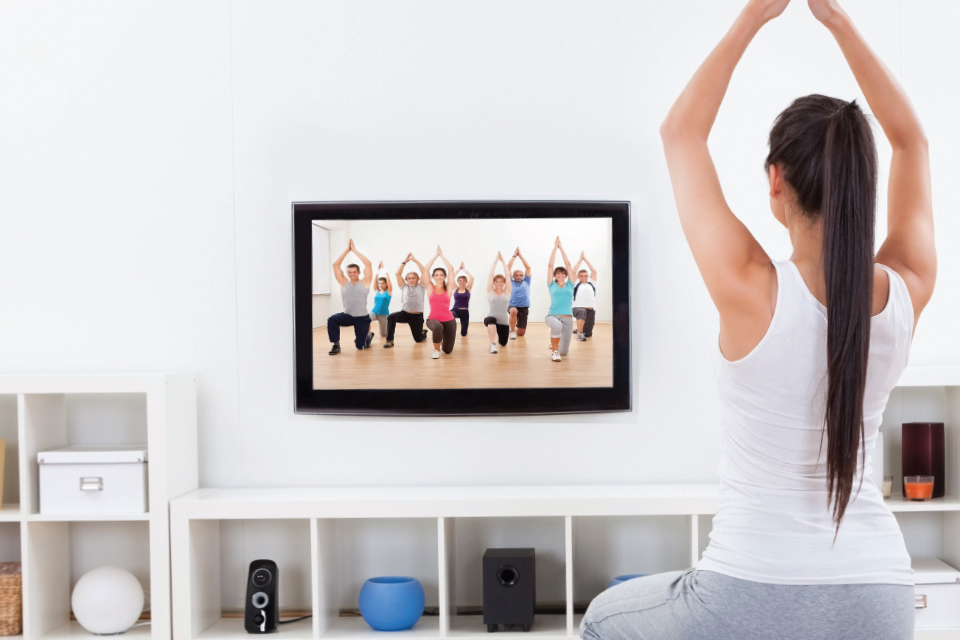Reaching for Home

Each year, I renew my goal to make yoga a part of my exercise routine. As a cardio-head and linear athlete (participating in running, swimming, and cycling), the discipline of attending a yoga class in the unfamiliar “Zen zone” has always eluded me. I have read countless stories about the tremendous benefits yoga can have for an endurance or power athlete. Benefits like injury prevention, improved joint mobility, increased power, quicker muscle repair, mental endurance, and enhanced breath control. However, when I start to consider carving out time to drive to the yoga studio and plunk down money for a class, I often end up lacing up my tennis shoes and going for a run instead.
With yoga studios popping up in every suburban shopping complex and downtown block in Austin, there is clearly no lack of available classes. Yet, for many individuals, the most convenient place to develop a consistent—and comfortable—yoga practice is in the privacy of their own home. While nothing can replace a pulsating room of bodies, the mingling of sweat vapors, the patchwork of colorful mats, and the communal inhale and exhale of breath, a home yoga practice has plenty of its own benefits to offer. This year, I decided to stick to my resolution and discovered yoga at home was exactly what I needed to finally work the practice into my routine. The convenience of being at home, having the ability to pick the duration of a class, as well as the opportunity to master poses at my own pace finally helped me turn my good intentions into reality.
In my quest to find the best home yoga practice, I met with two local teachers—both yoga enthusiasts who have expanded their instruction to the virtual studio. While both of these instructors espouse the importance of attending live yoga classes, they have created an alternative and engaging way to bring yoga into a home environment.
YogaStudio9.com
Lauran Janes, co-founder and instructor for YogaStudio9.com (The Yoga Life Project), created an Austin-based online resource with more than 100 different yoga class offerings—each taught by local instructors, with each class lasting anywhere from 5 to 60 minutes. The Yoga Life Project’s mission is to reveal how the practice of yoga can directly influence emotional well-being, physical strength, and mental stability off the mat. Practicing yoga, Janes said, is a method of improving our ability to gracefully navigate the ebb and flow of life. The project approaches yoga from a standpoint of transforming people’s lives from the inside out; a means of better understanding and healing emotions; a way to nourish minds and hearts.
The website touts a holistic approach for each individual yogi and teaches various classes: Beginner’s, Vinyasa, Tao, Prenatal, Restorative Yoga, and more. Also offered on the site are numerous interviews with practitioners, scientists, psychologists, academics, and philosophers that reveal yoga’s role in personal transformation and how the practice can help humans healthfully navigate the stresses of modern day life. Talking topics include “Yoga and Parenting,” “Yoga and Personal Transformation,” and “Yoga and Feminine Beauty.” All authentic dialogues intended to provide powerful messages of hope and inspiration to others.
Janes, who also instructs yoga classes non-virtually at Pure Austin, said that many athletes mistakenly approach yoga with an “athlete’s mentality” of pushing harder, being competitive, and wanting to make the practice a cardio workout. “I love athletes because their level of conditioning is so admirable. But most athletes try to ask their breath to keep up with the body,” Janes said. “Yoga teaches them to do the exact opposite—to guide the body around their breath. It teaches athletes to find the cadence [in their breathing], and let the body be steered by it.”
HeavyWeightYoga.com
Abby Lentz, another Austinite visionary and yoga enthusiast, set out on a mission a decade ago to introduce yoga to overweight and obese individuals. Her goal: to teach love of self and body. She felt there was a lack of welcoming yoga classes around town for those carrying extra weight, so she decided to start her own virtual studio. Lentz viewed the misconstrued image of yoga being only for those with pretzel-thin bodies as a deterrent; a social construct keeping many overweight individuals from receiving the benefits of yoga. So Lentz adapted her yoga practice to fit those with larger bodies and started her website, the slogan for which reads “Yoga For The Body You Have Today.” Over the years, Lentz has gained national media attention for her innovative practice and local classes, DVDs, and YouTube videos teaching her adapted version of the practice, which has now expanded to include yoga teacher certification—training other instructors to bring the heavy weight yoga practice to their studios.
Lentz’s underlying philosophy for the practice is founded on three A’s: awareness of body, acceptance of body, and affection for the body. The benefits of yoga are now accessible to overweight individuals through an intentional combination of pose pairing, the use of props to help with alignment and reach, and pacing that is slow. “No matter how you look, you can learn to do yoga and learn to love yourself,” Lentz said. “Self-love is the most important aspect [of yoga]. You can’t have any lasting change if you don’t love yourself first.”
Bringing Your Practice Home
By integrating online classes into your fitness routine, you can access all the physical, mental, and emotional benefits of yoga without having to leave home. While there is no substitute for an in-person yoga studio experience with other students, virtual studios can add convenience and variety to any yoga practice.






